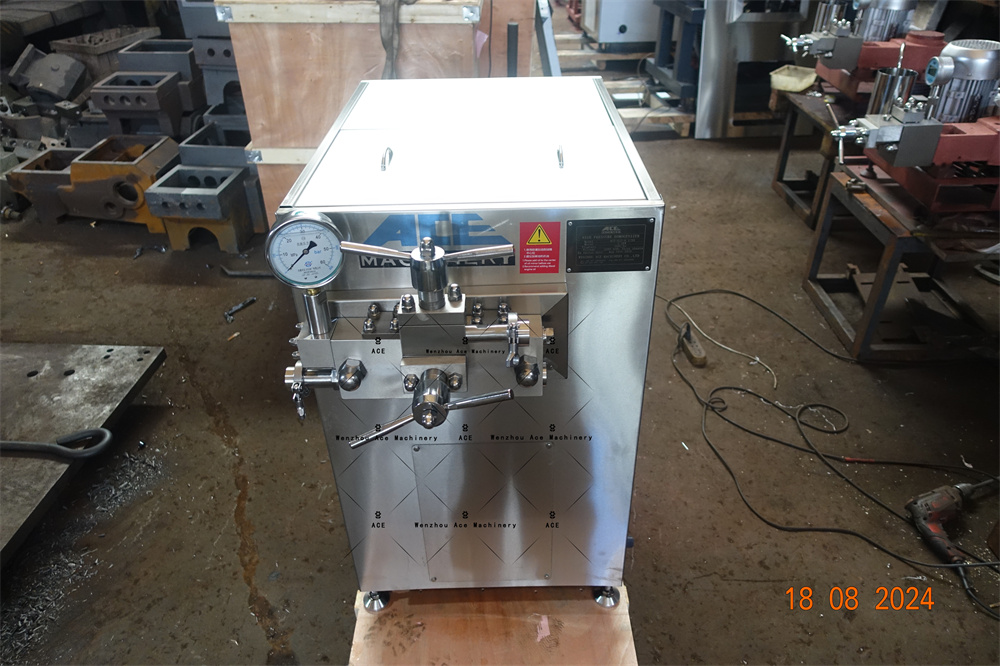The purpose of homogenization is to prevent fat from rising to the surface and stratifying, to reduce the precipitation of casein particles, to improve the rheological properties of the raw material or product and to distribute the added ingredients evenly.

Principle of Homogenization in Milk:
Homogenization is produced by the coordinated action of three factors:
- The buttermilk passes through the narrow gap in the homogenizing head at a high speed, which generates a huge shear force on the fat balls, which deforms, elongates and crushes the fat balls.
- Buttermilk liquid accelerated in the gap at the same time, the hydrostatic pressure can drop, may fall below the vapor pressure of the fat, which produces a cavitation phenomenon, so that the fat globules are subjected to a very strong bursting force.
- Further shearing forces are generated when the fat globules impact the homogenizing ring at high speed.
What is Homogenized milk
Characteristics of homogenized milk:
I. Homogeneity
The increase in the number of fat globules increases the chance of refraction and reflection of light in the buttermilk, making the homogenized milk whiter. After homogenization of the fat globules diameter size of 2 microns or fewer, evenly distributed in the milk, preventing the fat from floating, it is not easy to form a thin cream layer, so the fat is not easy to adhere to the inner wall of the milk storage tanks and the lid. After homogenization, in addition as the fat is evenly distributed in the milk, other nutrients, such as vitamin A and vitamin D are also evenly distributed to promote the absorption and assimilation of milk fat in the body.
Second, good flavor
Homogenized buttermilk has the aromatic odor of fresh buttermilk. Compared with non-homogenized buttermilk, homogenized buttermilk prevents the odor due to the catalytic effect of copper, which is due to homogenization to increase the surface area of fat. The surface area of fat globules of homogenized buttermilk increases, but the phospholipid and copper content remains almost unchanged, so the ratio of copper to phospholipid in the membrane is nearly constant, but its concentration is roughly inversely proportional to the surface area of the fat, so the contact between copper and phospholipids will be reduced, which reduces the oxidation of fat.
Third, foam
The number of fat globules increases after homogenization, and casein adheres to the surface of the fat globules, resulting in an increase in the total volume of the suspended matter, so that the viscosity of the homogenized milk is greater than that of this homogenized milk. When air is mixed in, the skimmed milk generates a lot of foam. When skim milk is homogenized under high pressure and concentrated before whipping and foaming, there is even more foam.
Disadvantages of homogenization:
- Homogenized buttermilk cannot be effectively separated.
- Homogenized buttermilk is sensitive to sunlight, and it immediately takes on a corrosive metallic taste (sunburned taste) when exposed to light, which has nothing to do with the milk fat, but rather with the milk pulp phase of the milk.
- homogenized cow’s milk protein heat stability is reduced. Therefore, in the production of sterilized milk, homogenization is best done at the end, otherwise there is a risk of protein coagulation during high temperature sterilization, which can lead to protein precipitation of buttermilk in the package.
- Homogenization of buttermilk is sensitive to attack by lipolytic enzymes. The well-known activation is caused by homogenization or vigorous stirring, and this activation may be due to the increased susceptibility of the substrate. The newly formed surface layer of fat globules after homogenization is different from its natural membrane and lacks protection against lipolysis, so homogenized buttermilk is susceptible to attack by lipolytic enzymes.






